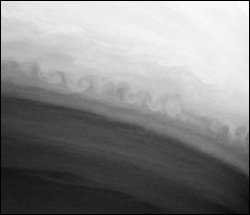

This turbulent boundary between two latitudinal bands in Saturn’s atmosphere curls repeatedly along its edge in this NASA/ESA/ASI Cassini-Huygens image.
This pattern is an example of a ’Kelvin-Helmholtz instability’, which occurs when two fluids of different density flow past each other at different speeds. This type of phenomenon should be fairly common on the gas-giant planets given their alternating jets and the different temperatures in their belts and zones.
The image was taken with the Cassini-Huygens spacecraft narrow-angle camera on 9 October 2004, at a distance of 5.9 million kilometres from Saturn through a filter sensitive to wavelengths of infrared light centred at 889 nanometres. The image scale is 69 kilometres per pixel.
The Cassini-Huygens mission is a co-operative project of NASA, ESA and ASI, the Italian space agency.












